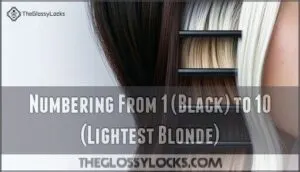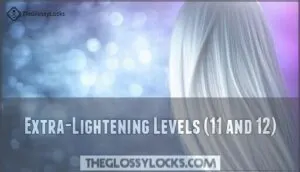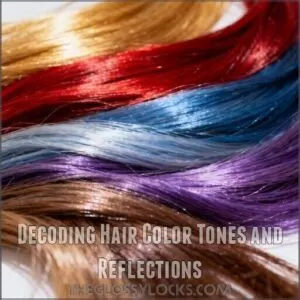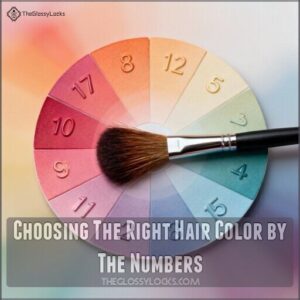This site is supported by our readers. We may earn a commission, at no cost to you, if you purchase through links.
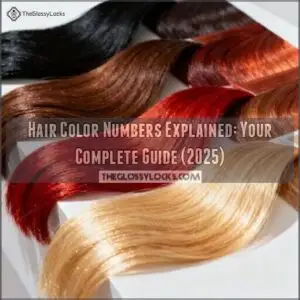 You’ve probably stood in the hair color aisle staring at a box labeled "7.43" or "6N" and wondered if you need a decoder ring to pick the right shade. Those cryptic numbers aren’t random—they’re a precise language that tells you exactly what color you’ll get, from depth to tone to underlying hues.
You’ve probably stood in the hair color aisle staring at a box labeled "7.43" or "6N" and wondered if you need a decoder ring to pick the right shade. Those cryptic numbers aren’t random—they’re a precise language that tells you exactly what color you’ll get, from depth to tone to underlying hues.
Professional colorists rely on this system every single day to create consistent results, whether they’re covering gray or crafting a sun-kissed balayage. Once you crack the code, you’ll never second-guess your color choice again.
The system works the same across most brands, and understanding just two key components—level and tone—puts you in control of your hair color destiny.
Table Of Contents
- Key Takeaways
- What Are Hair Color Numbers?
- How to Read Hair Color Levels
- Decoding Hair Color Tones and Reflections
- Real-World Examples of Hair Color Codes
- Choosing The Right Hair Color by The Numbers
- Frequently Asked Questions (FAQs)
- How do I know which hair color number is right for me?
- What are the risks associated with bleaching my hair?
- What is the difference between a primary and a secondary tone?
- How do I keep my hair color looking its best?
- Is it necessary to consult a professional hairdresser?
- How do hair color numbers affect processing time?
- Can you mix different hair color numbers together?
- What numbers work best for covering gray hair?
- Do hair color numbers fade at different rates?
- Which numbers require pre-lightening or bleaching first?
- Conclusion
Key Takeaways
- Hair color numbers use a universal system where the first digit (1-10) indicates depth from black to lightest blonde, while numbers after the decimal reveal tone and warmth—giving you precise control over your final shade.
- The primary tone (first number after the decimal) determines your dominant color family, while the secondary reflection adds subtle dimension, working together to neutralize or enhance underlying pigment.
- You can’t jump more than two levels lighter without pre-lightening or bleach—matching your natural starting level prevents patchy results and ensures your chosen number actually works on your hair.
- Ash tones with green-blue reflects cancel brassiness, purple neutralizes yellow in blondes, and understanding this color wheel opposition prevents common mistakes like unwanted orange or green tints.
What Are Hair Color Numbers?
Hair color numbers might seem like a secret code at first glance. They’re actually a simple system that tells you exactly what shade you’re getting before you open the box.
Understanding how these numbers work helps you pick the right color and avoid surprises.
Purpose of Hair Color Numbering
Hair color numbering takes the guesswork out of picking your perfect shade—no more pointing at a picture and hoping for the best. This standardized hair color numbering system fulfills four essential purposes:
- Color consistency – You’ll get the same shade every time you buy it
- Formulation accuracy – Colorists mix precise ratios for predictable results
- Client communication – You can describe exactly what you want using hair color codes
- Professional standards – Understanding hair color numbering creates universal shade matching across brands
Decoding hair color codes puts you in control of your color journey.
Hair Color Numbering Systems Overview
Most professional brands follow the International Colour Chart (ICC), which uses numbers separated by a decimal, slash, or hyphen. Understanding hair color numbering starts with recognizing that the system before the separator indicates depth (1–10), while numbers after show tone.
Though hair color numbering systems share this basic structure, brand numbering variations exist—some companies use letters instead of numbers for tones, and certain lines extend to levels 11 or 12.
Despite system accuracy issues across manufacturers, decoding hair color codes becomes straightforward once you grasp the universal framework. The first number in the code indicates hair color depth.
International Standards (e.g., L’Oréal Professionnel)
The L’Oréal Professionnel colour numbering system stands as the backbone of global standardization in hair color codes. Used across over 150 countries, this hair color numbering system lets colorists worldwide speak the same language—no translation needed.
While the International Colour Chart (ICC) ensures color consistency, brand variations still exist. Regional preferences mean some markets blend letters with numbers, but professional training worldwide centers on L’Oréal’s framework, keeping hair color levels predictable salon to salon.
This system helps professionals understand hair color charts to determine shades and tones.
How to Read Hair Color Levels
The first number on any hair color box tells you the level, which is your starting point for understanding depth. This system runs from 1 to 10, with some brands pushing even lighter.
Let’s break down how these numbers work so you can decode any box you pick up.
Numbering From 1 (Black) to 10 (Lightest Blonde)
Think of hair color levels as a ladder—each step takes you from deep shadow at the bottom to bright sunlight at the top. Level 1 is black, your darkest starting point. Level 5 sits in the medium brown range. Level 10 brings you to the lightest blonde.
Hair color levels work like a ladder from darkness to light—level 1 is black, level 5 is medium brown, and level 10 is the lightest blonde
Understanding hair color levels helps you match your natural hair or choose your target shade with color level accuracy. Most hair color charts display this numbering system clearly, making gray coverage levels and consultation easier.
Extra-Lightening Levels (11 and 12)
When you push past level 10, you enter the zone of ultra-light shades that can only be reached with high-lift color or bleach. Levels 11 and 12 represent extreme lightening—think platinum and icy blonde.
Understanding hair color levels at this stage means knowing the damage potential increases dramatically. You’ll need toner application to neutralize brassy tones and maintain your color.
This hair color guide recommends professional consultation before attempting these depth levels.
Differences Between Brands
Here’s the thing: not every brand speaks the same language regarding hair color numbers. L’Oréal might use ".1" for ash, while Wella assigns different tone codes entirely. Schwarzkopf uses dashes instead of decimals, and their numbering scheme places tones differently.
Coverage formulations also vary—Redken’s "NN" series packs double pigmentation for gray coverage. Regional charts differ too, especially between European and North American lines.
Always consult each brand’s chart before mixing or matching hair color codes.
Decoding Hair Color Tones and Reflections
You’ve already figured out the level number, but there’s more to the code. The numbers after the decimal point tell you about tone and reflection.
Understanding these digits helps you predict whether your color will lean warm, cool, or neutral.
Numbers After The Decimal/Slash
The digits after the decimal point or slash in your hair color code are where the magic really happens—they tell you exactly what tone and warmth you’ll see in the mirror.
These hair color numbers reveal your primary reflects and secondary reflects, which work together to create the final shade. The first number shows the dominant color family, while any additional digits indicate secondary tones that add depth.
Understanding these hair colour numbers helps you pick neutralizing tones or try custom mixing for your perfect match.
Primary Tone Vs. Secondary Reflection
If you think of a hair color formula as a recipe, the primary tone is your main ingredient and the secondary reflection is the subtle seasoning that rounds everything out.
Here’s how primary reflects and secondary reflects interact to create your final hair color shades:
- Dominant Hue – The first number after the decimal controls warmth vs. coolness and sets your main color depth
- Underlying Reflection – The second number adds dimension without overpowering the primary
- Tone Interaction – Both hair color numbers work together to neutralize or boost existing pigment
- Visual Impact – Primary shows strongly; secondary whispers through as highlights catch light
Understanding this hair color tones partnership helps you predict your true result.
Letters in Hair Color Codes (e.g., /N, /A, /G)
Some brands skip the numbers entirely and stamp a letter right after the slash—think of it as their shorthand for describing exactly what kind of warmth, coolness, or shimmer you’re about to get. /N means neutral, /A signals ash, /G brings green-based correction, and /R adds red warmth.
These tone indicators help you decode hair color codes fast. You’ll see brand variations—some use /W for warm or /C for copper—but the logic stays the same across hair color shades.
Real-World Examples of Hair Color Codes
Let’s look at how these numbers work in practice. You’ll see what specific codes mean, how charts display the full range, and why certain shades are more common in different parts of the world.
Sample Numbering and What They Mean
Let’s crack the code on a few common hair color numbers so you can see exactly how the system works in action.
- 5.3 – Level 5 (light brown) with a.3 primary tone (golden reflection). You’ll get warm, sun-kissed brown hair with shade accuracy that leans golden rather than ash.
- 7.1 – Level 7 (blonde) with a.1 ash tone. This code breakdown delivers cool-toned blonde hair, neutralizing any brassy warmth.
- 4.56 – Level 4 (medium brown) with mahogany-red reflections. The colour numbering system shows both primary (.5 mahogany) and secondary (.6 red) color tones for richer dimension.
Visual Hair Color Charts
Hair color charts turn those numbered codes into something you can actually see—swatches arranged from darkest to lightest, with every tone and reflection laid out in one visual guide. Most salons display physical charts at the color station, but digital color tools and virtual try-ons now let you preview shades on your phone before you commit.
Understanding hair color becomes easier when you match the codes you’ve learned to actual swatches, making chart accessibility essential for reading hair color codes confidently.
Regional Shade Variations
Charts show you what codes look like, but shade prevalence shifts dramatically by region because of genetic ancestry and cultural influences. Market trends follow these patterns—hair color charts in Scandinavia display more level 8–10 blondes, while Asian markets focus on levels 2–4 blacks and browns. Understanding color diversity helps you match hair color tones to local demographics:
- Northern Europe – Blonde and light brown shades (levels 7–10) dominate with up to 80% prevalence in Finland
- East Asia – Black hair (levels 2–3) exceeds 90% in China, Japan, and Korea
- Southern Europe – Dark brown and black (levels 1–4) account for over 85% in Italy and Spain
- Americas – Mixed genetic backgrounds create wider hair color levels and shades across urban populations
Choosing The Right Hair Color by The Numbers
Understanding the numbers is just the first step—now you need to know how to use them. Matching your natural level, correcting unwanted tones, and avoiding common mistakes can make or break your color results.
Here’s what you need to think about before picking a shade.
Matching Numbers to Natural Hair Level
Your natural starting point is the number on your own head—before you pick any shade, you need to know where you’re beginning. Check your natural hair color level against a chart. If you’re a level 5, you can’t jump straight to level 10 without pre-lightening needs.
For gray coverage, match your base color level to avoid patchy results and make certain root blending works smoothly with your hair color depth.
Neutralizing Unwanted Tones
When brassy orange, unwanted yellow, or stubborn red keeps showing up in your finished color, you need to fight it with its opposite on the color wheel. Ash tones (green-blue reflects) cancel out brassiness correction from warm tones. Purple toner selection neutralizes unwanted hair tones in yellow blondes.
Understanding color theory and color neutralization prevents green hair mishaps—you’re working with hair color tones and reflects, not guessing.
Tips for Achieving Desired Results
Getting from "I want that shade" to actually seeing it in the mirror takes more than picking the right number—you need a game plan. Start with strand tests before committing to full application.
Timing precision matters—leave color on too long and you’ll overshoot your target. Developer consultation guides lift strength.
Master your hair color application techniques, then lock in hair color results with proper post-color care to maintain vibrancy.
Frequently Asked Questions (FAQs)
How do I know which hair color number is right for me?
In 2024, women accounted for 71% of hair color product adoption, yet many still struggle with shade selection. Start by identifying your base hair color level—that’s your natural depth.
Then consider skin tone, eye color, and lifestyle factors like maintenance needs. Professional consultation helps match color tones and reflects to complement your features.
What are the risks associated with bleaching my hair?
Bleaching causes Hair Damage through weakened strands and breakage. You’ll risk Scalp Irritation, Allergic Reactions, and Over-Processing.
The Lightening Process can create Uneven Lift if timing’s off.
Proper Hair Color Techniques protect you during the Hair Color Process.
What is the difference between a primary and a secondary tone?
Think of tone like layers in a painting—the primary tone is your bold brushstroke, the secondary tone adds subtle depth. Your primary tone determines color warmth and shade visibility, creating the dominant hue.
The secondary tone offers gentler hue reflection, influencing hair color tones and reflects with less tone dominance but adding richness to your final color shade.
How do I keep my hair color looking its best?
Protect your investment with sulfate-free shampoo and hydration masks weekly.
Schedule root touch-ups every 4–6 weeks to keep hair color fresh.
UV protection sprays prevent color fade and maintain vibrancy between hair treatments.
Is it necessary to consult a professional hairdresser?
Professionals bring color consultation expertise and reduce DIY risks like uneven results or damaged hair. Complex coloring techniques need trained hands.
However, simple root touch-ups or single-process hair dye applications can work at home if you follow instructions carefully and understand your hair’s health needs.
How do hair color numbers affect processing time?
Here’s the bottom line: developer volume and color level are the real timekeepers. Darker shades process faster than lighter ones.
Tone doesn’t affect timing much, but your hair’s porosity does. Heat application speeds things up too.
Can you mix different hair color numbers together?
Yes, you can mix different hair color numbers together. Colorists combine color levels and tones to create custom formulations. Mixing lets you adjust depth and neutralize unwanted shades.
Always use the same developer and follow proper formulation ratios for expected results.
What numbers work best for covering gray hair?
Gray coverage levels 5 through 7 work best, using neutral base shades for resistant gray solutions.
Hair colour formulas with low-numbered tones, like.0 or.1, guarantee even blending.
Pre-pigmentation needs vary by texture and percentage.
Do hair color numbers fade at different rates?
Like a delicate watercolor painting left in the sun, lighter shades with warmer tones disappear faster than darker ones.
Level impact fading varies because shade formulation affects how color pigments grip your strands during the hair color process.
Which numbers require pre-lightening or bleaching first?
Lifting hair more than two levels requires bleach necessity to avoid lift limitations. Darker levels (1-5) need pre-lightening before applying lightening process shades like 8- Without damage control measures, skipping this step leaves hair color depth levels unchanged and causes uneven tone correction.
Understanding hair color numbers explained prevents poor hair color process results.
Conclusion
Think of hair color numbers like GPS coordinates—they pinpoint your exact destination before you even start the journey. Once you understand how levels and tones work together, you’ll never grab the wrong box or wonder why your blonde turned brassy.
The hair color numbers system gives you a universal language that works across brands and salons. You’re no longer guessing. You’re choosing with precision. And that confidence shows every time you look in the mirror.
- https://www.revlonprofessional.com/blog/how-to-understand-the-numbers-and-letters-on-hair-color-charts/
- https://rumbie.co/hair-colour-chart-understanding-hair-tones-and-levels/
- https://www.uglyducklingcolor.com/content/52-how-the-coloring-number-system-works
- https://www.grandviewresearch.com/industry-analysis/hair-color-market-report
- https://www.forinsightsconsultancy.com/reports/hair-color-market

